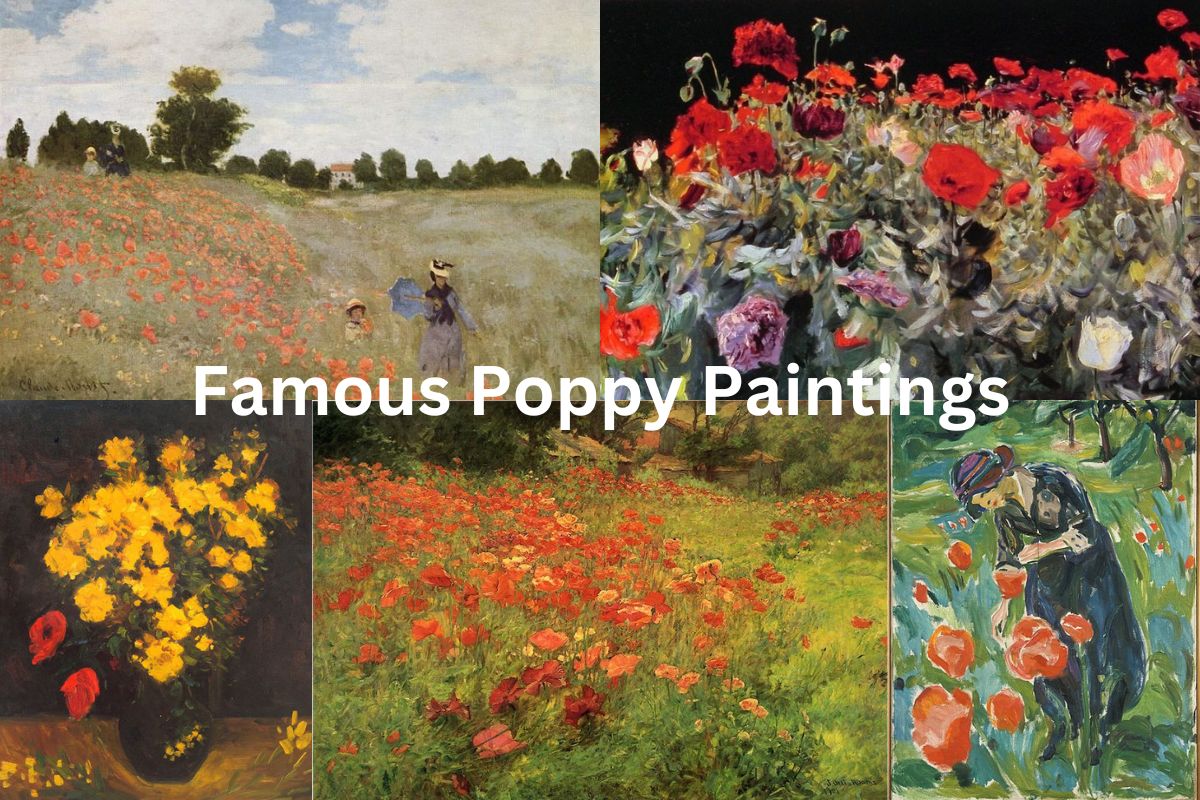Poppies have long fascinated artists, who have been captivated by their vibrant colors, delicate petals, and symbolic meanings.
Throughout art history, poppies have represented life, death, remembrance, and even sleep due to the opium derived from some varieties of the flower.
As a result, many renowned artists have been inspired to capture the beauty of these blooms in their work. Below are some famous poppy paintings that showcase the allure of these flowers and the diverse artistic styles that have immortalized them.
These famous poppy paintings not only celebrate the beauty of the flowers but also demonstrate the remarkable skill and creativity of the artists who brought them to life.
From Impressionism to Expressionism, these works span a range of artistic movements and styles, each providing a unique perspective on the enduring appeal of the poppy.
Famous Poppy Paintings
1. Wild Poppies, near Argenteuil – Claude Monet
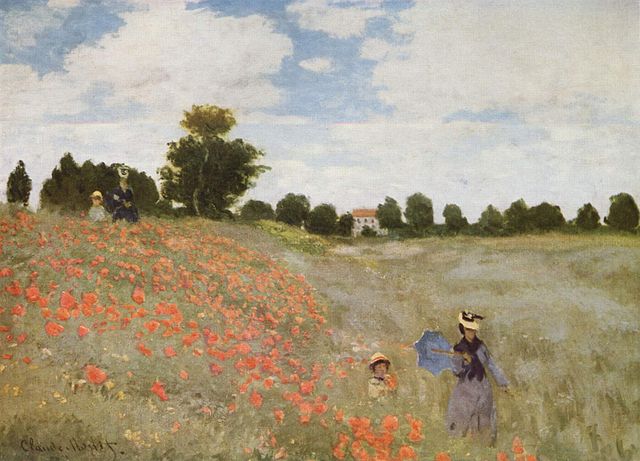
“Wild Poppies, near Argenteuil” is a famous painting by the French Impressionist artist Claude Monet, created in 1873.
Also commonly known as “Poppies near Argenteuil” or “Coquelicots, La promenade,” this work showcases Monet’s remarkable ability to capture the essence of a landscape, as well as his interest in light and color.
The painting depicts a scene of a field of vibrant red poppies with a woman and a child strolling among them. Monet’s wife, Camille, and their son, Jean, are believed to be the figures in the scene.
The combination of the bright red poppies, the green fields, and the blue sky creates a beautiful contrast of colors, capturing the essence of a sunny day.
In the background, we can see the small town of Argenteuil, which was located northwest of Paris. During the 1870s, Argenteuil became a popular destination for Impressionist artists, including Monet, who lived there between 1871 and 1878.
“Wild Poppies, near Argenteuil” is considered one of Monet’s most iconic works and is a prime example of Impressionist landscape painting. Today, the painting is housed in the Musée d’Orsay in Paris, France.
2. Poppy Flowers – Vincent van Gogh
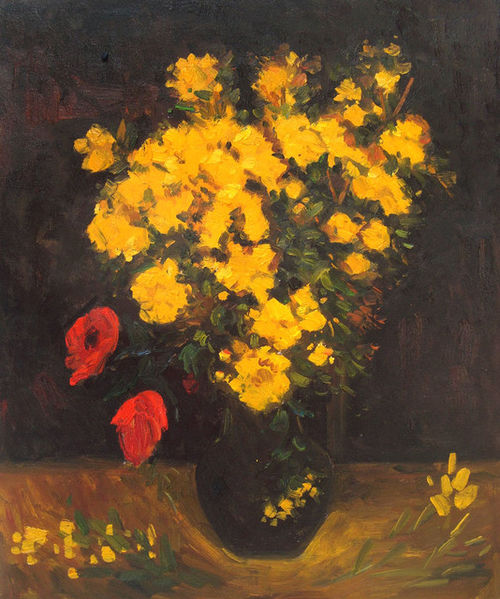
“Poppy Flowers,” also known as “Vase with Viscaria,” is a painting by the renowned Dutch post-Impressionist artist Vincent van Gogh.
Created in 1887, this artwork features a vase filled with an arrangement of poppies and other flowers. The painting is a prime example of Van Gogh’s unique style and bold use of color.
In “Poppy Flowers,” Van Gogh employs a vivid color palette, with contrasting red poppies and yellow flowers against a deep blue-green background. The brushstrokes are expressive and energetic, showcasing his signature technique.
The composition focuses on the flowers, leaving little space for the background or surrounding elements, which draws the viewer’s attention to the vibrant blooms.
Unfortunately, “Poppy Flowers” has a somewhat notorious history, as it has been stolen twice from the Mohamed Mahmoud Khalil Museum in Cairo, Egypt.
The first theft occurred in 1977, but the painting was recovered ten years later. The second theft took place in 2010, and the painting remains missing to this day.
Despite its turbulent history, “Poppy Flowers” is still regarded as a significant work by Van Gogh, demonstrating his incredible skill and passion for depicting the beauty of nature.
3. Poppy Field – Gustav Klimt
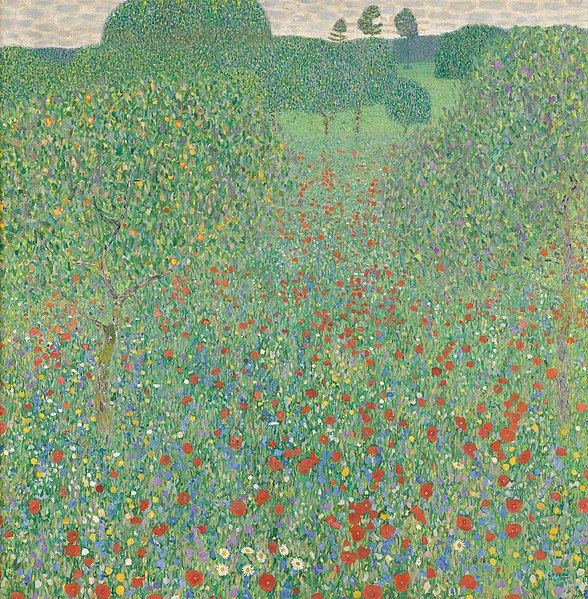
“Farm Garden with Sunflowers” (also known as “Bauerngarten”), features both sunflowers and poppies. Klimt, an Austrian symbolist painter, is renowned for his intricate and decorative style, often incorporating gold leaf into his works.
Created in 1907, “Farm Garden with Sunflowers” is an exquisite example of Klimt’s landscape paintings. The painting showcases a colorful and lush garden filled with various flowers, including sunflowers, poppies, and other blooms.
Klimt’s unique style is evident in the ornamental patterns and shapes that fill the canvas, capturing the essence of the vibrant garden.
The composition is bursting with life and energy, as the flowers seem to grow and overlap with one another. Klimt’s bold use of color adds to the painting’s visual impact, with the vivid red poppies contrasting against the bright yellow sunflowers and the deep blues and greens of the foliage.
Although Klimt is perhaps best known for his portraits and allegorical works, such as “The Kiss” and “Portrait of Adele Bloch-Bauer I,” his landscape paintings, like “Farm Garden with Sunflowers,” demonstrate his incredible talent for capturing the beauty and vibrancy of the natural world.
4. Poppy Field – Vincent van Gogh
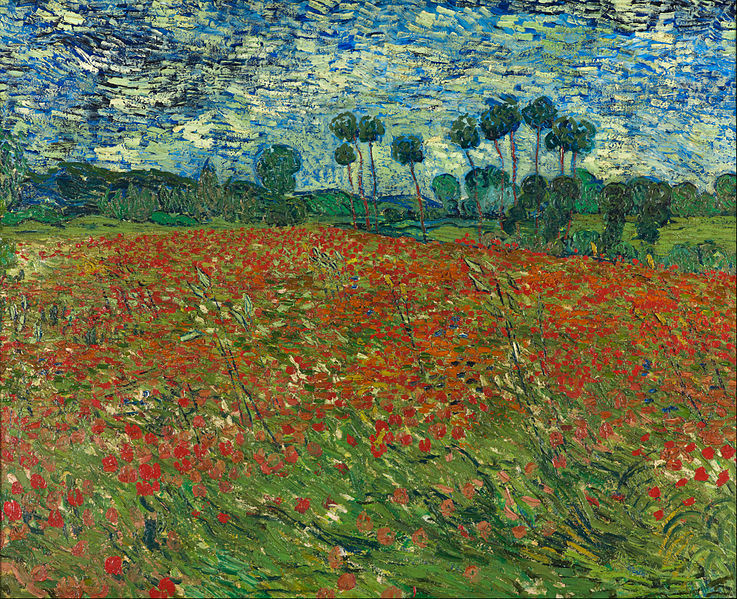
Vincent van Gogh’s painting Poppy Field was completed in 1890. It has been described as “a composition that verges on the abstract,” and it differs significantly from an 1888 painting of the same subject that is currently housed in Amsterdam’s Van Gogh Museum.
The picture is on display at The Hague’s Kunstmuseum. After being taken over by the Nazis during WWII, it was returned to Dutch hands; the Kunstmuseum anticipates that it will be returned to its original private owners.
5. Poppy Fields (Giverny) – Claude Monet
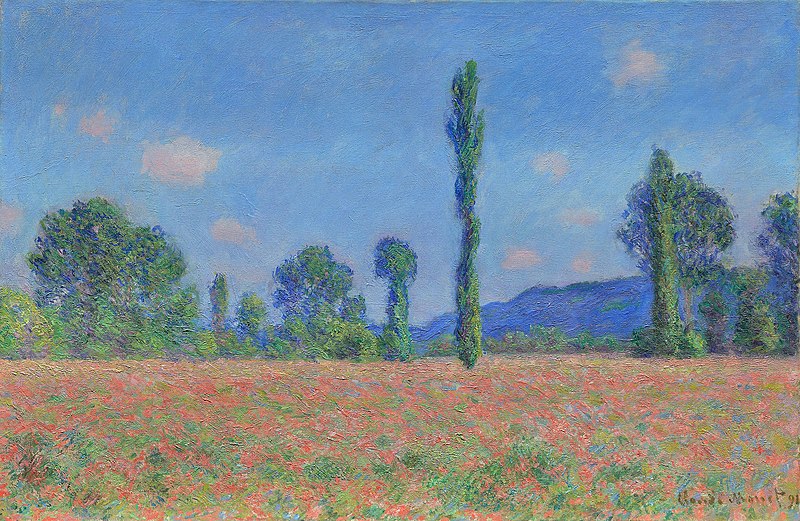
“Poppy Field (Giverny)” is a painting by the French Impressionist artist Claude Monet, created around 1890-91. Monet is known for his mastery of capturing the beauty of nature, light, and color in his landscape paintings.
Giverny is a small village in northern France where Monet lived from 1883 until his death in 1926. It was here that he created his famous water lily series and cultivated a stunning garden that served as inspiration for many of his works.
“Poppy Field (Giverny)” features a lush, vibrant field of red poppies, with contrasting green foliage and a few scattered trees. The sky above is painted in soft blues and whites, giving the painting a dreamy, atmospheric quality.
Monet’s distinctive loose brushstrokes and the interplay of light and color in the scene are typical of his Impressionist style.
Though this particular painting is less well-known compared to “Poppies near Argenteuil” (1873), it is still a beautiful example of Monet’s talent for capturing the essence of the natural world.
His various works featuring poppies and other floral landscapes remain iconic and continue to captivate viewers with their timeless beauty.
6. Poppies – John Singer Sargent
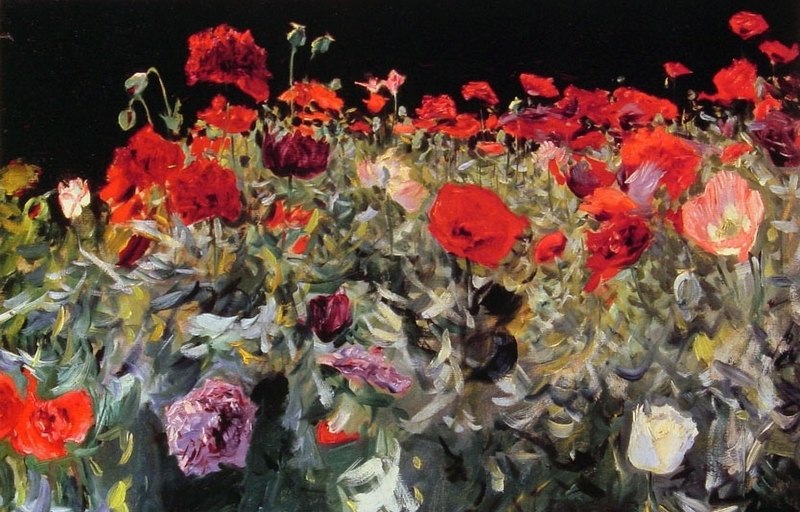
“Poppies” is a painting by the prominent American artist John Singer Sargent, created in 1886. Known for his portraits and landscape paintings, Sargent was a leading figure in the art world during the late 19th and early 20th centuries.
In “Poppies,” Sargent presents a serene, Impressionistic scene featuring a field of wild red poppies in full bloom. The painting captures the delicate beauty of the flowers, as well as the light and atmosphere of the outdoor setting.
Sargent’s skillful brushwork and keen attention to detail are evident in the way he renders the individual petals and the soft play of light across the field.
While Sargent is perhaps best known for his striking portraits, such as “Madame X” and “Carnation, Lily, Lily, Rose,” his landscape paintings like “Poppies” demonstrate his remarkable versatility and talent as an artist.
These works reveal his ability to capture the essence of the natural world in a way that is both visually appealing and evocative.
7. Oriental Poppies – Georgia O’Keeffe
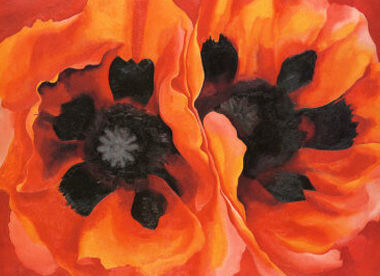
“Oriental Poppies” is a striking painting by the American artist Georgia O’Keeffe, created in 1927. Some of Georgia O’Keeffe paintings are renowned for her close-up views of flowers.
Her innovative approach to depicting flowers with an enlarged, close-up perspective provided viewers with a new way of seeing and appreciating the natural world.
In “Oriental Poppies,” O’Keeffe presents two large, red-orange poppies in bloom, dominating the canvas. The flowers are depicted with incredible detail, allowing the viewer to observe the delicate texture and structure of the petals.
The background is a solid, dark color that contrasts with the bright red and orange hues of the poppies, making them the central focus of the painting.
O’Keeffe’s intention with paintings like “Oriental Poppies” was to encourage viewers to take the time to truly observe the beauty and intricacy of the flowers, as if they were seeing them for the first time.
Through her unique artistic vision, O’Keeffe managed to transform ordinary subjects like flowers into something extraordinary and captivating.
8. Woman with Poppies – Edvard Munch
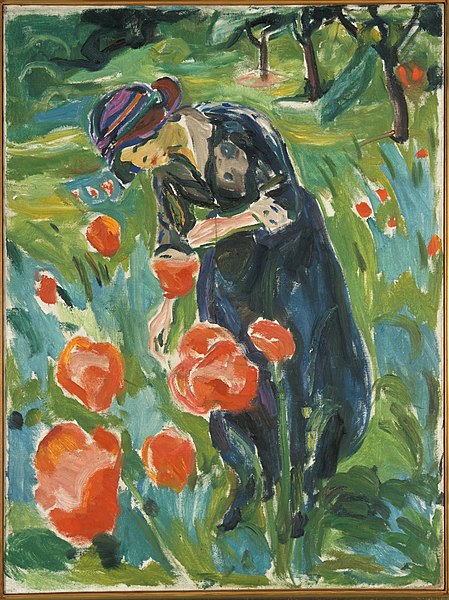
“Woman with Poppies” by Edvard Munch, created around 1919. Munch, a Norwegian painter and printmaker, was a pioneer of the Expressionist movement and is best known for his iconic work “The Scream.”
Munch depicts a young woman standing in a field of poppies. The painting showcases his signature use of bold colors and expressive brushstrokes.
The girl’s face and posture suggest introspection and a sense of melancholy, which is characteristic of Munch’s work, as he often explored themes of love, death, and psychological turmoil.
While this particular painting may not be as famous as some of his other works, it serves as a good example of Munch’s talent for capturing the human condition and his ability to evoke emotion through his art.
9. In Poppyland – J. Ottis Adams
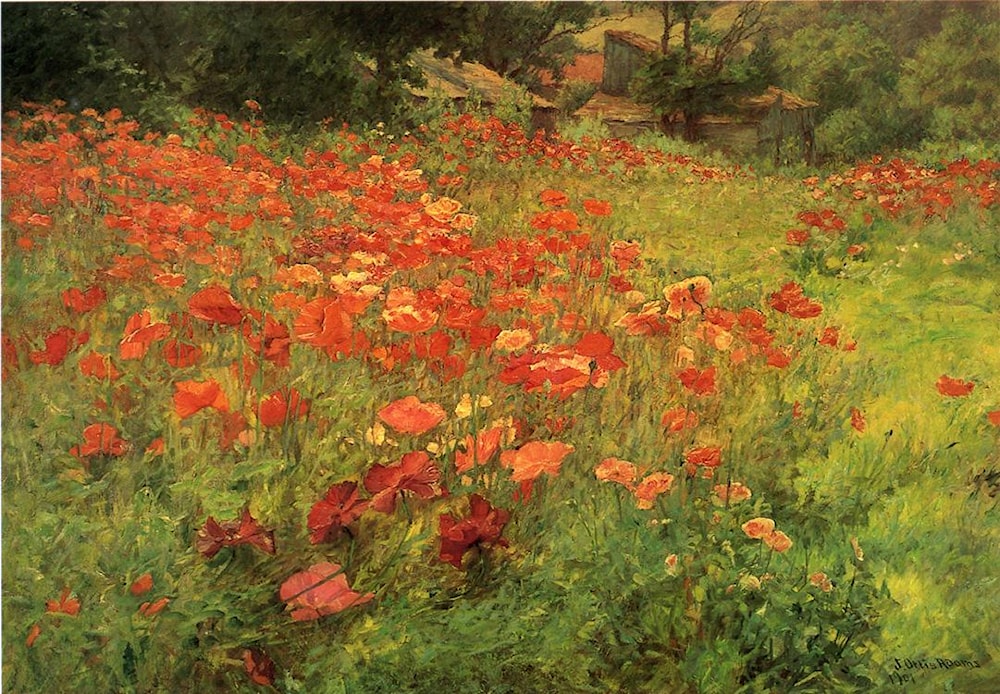
“In Poppyland” is a painting by American Impressionist artist John Ottis Adams, created in 1901. J. Ottis Adams was a prominent artist in the Hoosier Group, which was a group of Indiana-based Impressionist painters active in the late 19th and early 20th centuries.
Adams was known for his landscape paintings, which often depicted scenes from Indiana and the Midwest.
“In Poppyland” features a field of blooming red poppies, with a few trees in the background. The painting captures the beauty and tranquility of nature, showcasing Adams’ skill in portraying light, color, and atmosphere.
His brushwork is loose and expressive, which is typical of the Impressionist style.
The painting reflects Adams’ interest in capturing the essence of the landscape and the fleeting effects of light and weather on the natural world. “In Poppyland” is an excellent example of his talent and contribution to American Impressionism.
10. Roses, Convolvulus, Poppies, and Other Flowers in an Urn on a Stone Ledge – Rachel Ruysch
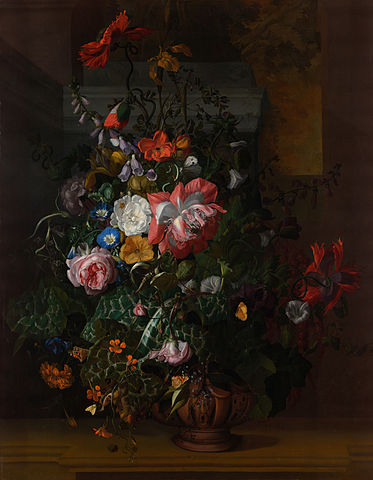
“Roses, Convolvulus, Poppies, and Other Flowers in an Urn on a Stone Ledge” is a painting by Dutch artist Rachel Ruysch, created around 1680.
Ruysch was a prominent still life painter during the Dutch Golden Age, specializing in floral arrangements. Her work is known for its intricate detail, realism, and composition.
In this painting, Ruysch masterfully arranges a variety of flowers, including roses, convolvulus, poppies, and other blossoms, in an ornate urn placed on a stone ledge.
The detailed depiction of each flower and leaf showcases her exceptional skill and keen observation of nature. The composition is well-balanced, with a sense of depth and texture created through her use of light and shadow.
Ruysch’s work, including “Roses, Convolvulus, Poppies, and Other Flowers in an Urn on a Stone Ledge,” demonstrates the enduring appeal of still life painting during the Dutch Golden Age. Her intricate floral compositions continue to captivate viewers with their beauty and technical prowess.

